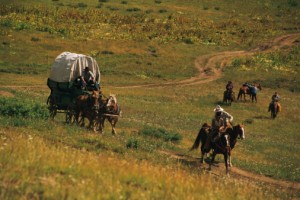Fertility: Canadian Pioneer Style

(Comstock)
Pioneers breed like rabbits, or so says a new study published in Science and reviewed in Scientific American. The study analyzed marriage and birth records in Canada’s Charlevoix Saguenay Lac-Saint-Jean region (northeast of Quebec City) and found that “families living on the edges of the expansions had 20 percent more children than families living at the settlement’s core. They also married one year earlier, on average, and contributed up to four times more genes to the region’s current population.” Henry Harpending, an anthropologist unaffiliated with the study, compares the behavior of pioneers to plant species:
The notion that pioneers tend to have more babies is consistent with the behavior of other species. Expose a bare patch of land, and the first plants to colonize it will most likely be species that grow quickly, reproduce early, and create many offspring. But these early colonizers eventually cede space to other plants that are slower growing but more efficient at using resources such as water, nutrients and space. Shrubs and trees, for instance, grow slowly and produce fewer offspring, but invest enough energy and resources in those offspring to make them highly competitive in the long run.
Humans are generally more like shrubs and trees: slow growing (children take more than a decade to reach adulthood) and efficient consumers of resources. (Quick-breeding rabbits and mice, by contrast, are the weeds of the mammal world.) But a change in environment can turn a slow grower into a weed. That is what happened, Harpending says, when North American settlers found themselves on the fringes of civilization.
Interestingly, pioneers passed these tendencies on to their children: “Pioneering ancestors with high fertility had children who also eventually had high fertility, although those effects were moderated by whether the offspring lived on the frontier or within the colony’s core.”

Comments